Plan your Chengdu tour? If you are into the Taoism (also spelled Daoism) , a religion and a philosophy from ancient China, Qingyang Palace is definitely your cup of tea.
ABC of Qingyang Palace
The Qingyang Palace, also known as Qingyang Taoist Temple, is lauded as “No 01 Taoist Temple in Sichuan” and “No.01 Taoist Temple in West China”. Now It is a famous tourism and sightseeing attraction of Taoist cultural heritage.
First built in Zhou Dynasty (1046 BC-249BC), Qingyang Taoist Temple was originally called Qingyang Fair. In the first year of Zhonghe Period (881) of Xizhong Reign of Tang Dynasty (618-907), the emperor retreated to the place of Qingyang Temple to avoid the chaos.
After the upheaval was calmed down, the emperor allocated a sum of money to expand the temple and issued an imperial edict to change the name of the place into Qingyang Palace. This temple was flourishing in Tang Dynasty.
In Ming Dynasty (1368 – 1644), the temple buildings built in Tang Dynasty were unfortunately damaged in natural disaster and wars. Today’s Qingyang Palace is the result of successive reconstructions during the six to tenth year of Kangxi of Qing Dynasty (1644 – 1911).
How to get there and tickets
Qingyang Palace is located to the east of Du Fu Cottage and to the north of Wu Hou Shrine. It is easily accessible by public transport.
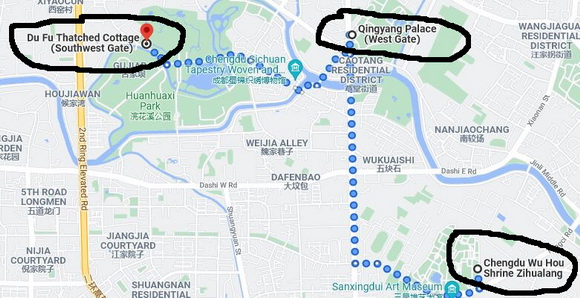
Bus lines: Bus No. 11, 19, 27A, 27, 34A, 34, 35, 42, 58, 59A, 59, 82, 129, 151, 165, 170, 309, 319 and get off at Qingyanggong Station
Subway lines: Line 2 or line 4, get off at the Provincial Hospital of Traditional Chinese Medicine Station and walk south;
Take subway Line 5 and alight at Qingyanggong Subway Station ( Exit D )
Admission Fee: RMB 10
Opening Hours: 08:00-18:00 all year round
Suggested visiting time: one hour
The temple is to the east of Du Fu Cottage and to the north of Wuhou Temple.
Virtual Tour of Qingyang Taoist Temple
Follow us to enter the main gate to Qingyang Palace and start the virtual tour.
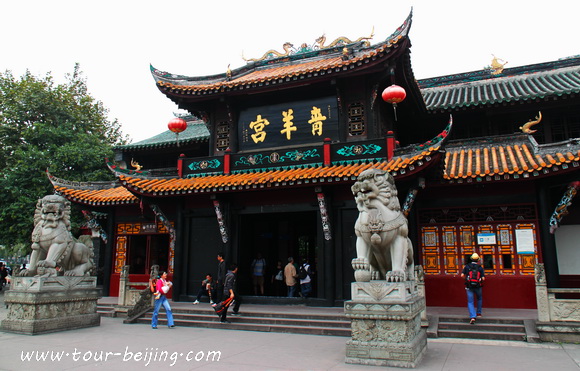
Hunyuan Hall
Going through the gate, and the first building you will see is the second important hall in the temple known as Hunyuan Hall. The hall was rebuilt during reign of Kangxi emperor (4 May 1654 – 20 December 1722) in Qing Dynasty.
The hall is about 22 meters high and suppported by 28 columns and covers an area of 600 square mteters. Enshrined in the hall are Taishang Laojun and Goddess of Great Compassion.

The Bagua (Eight Trigrams) Pavillion
The Bagua (Eight Trigrams) Pavillion is an octagonal pavilion where the statue of Laozi riding on a bronze cow is enshrined and well preserved.
Constructed on square bases, with a colored glazed dome on top, this octagonal building showcases the ancient Chinese thinking that “the sky is round and the earth is square”.
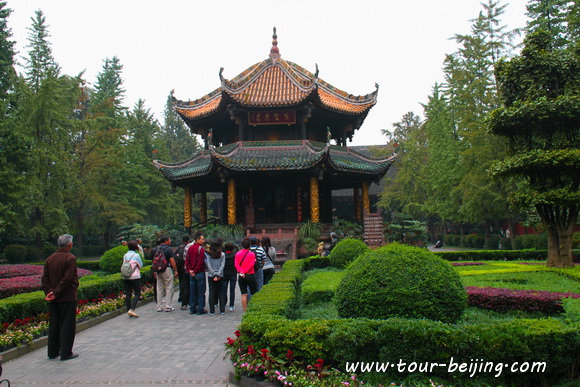
Sanqing Hall
Sanqing Hall, also known as Wuji Hall, is the main hall of Qingyang Palace. It was originally built in the Tang Dynasty and rebuilt in 1669 ( the eighth year during the raign of Emperor Kangxi ) in Qing Dynasty.
Sanqing Hall is dedicated to the worship of the three highest Taoist deities in Taoism – Yuanshi Tianzun, Lingbao Tianzun and Daode Tianzun.
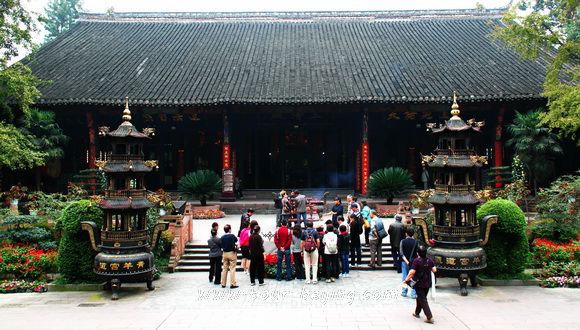
In front of the Sanqing Hall stand two eye-catching bronze goats. Two bronze goats are a veritable treasure of the palace.
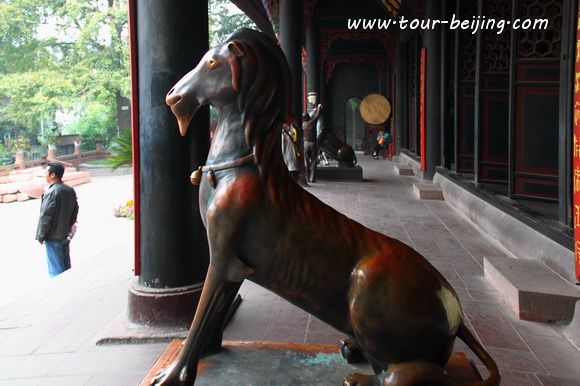
Doulao Hall
Doulao Hall where Doulao, a great Goddess in Taoist is enshrined. Doulao Hall, also known as Yuanchen Hall, is about ten meters long and nine meters wide. It was built in the Ming Dynasty ( 1368 – 1644) . Doulao Hall is the only existing Ming Dynasty original building in Qingyang Palace.
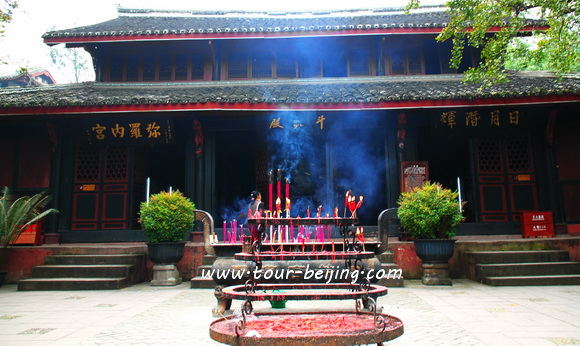
The Jade Emperor Hall
The Jade Emperor Hall. According to the doctrine of Taoism, the Jade Emperor is the most senior God of the world. The original hall of the Jade Emperor was built during the reign (1821-1850) of Emperor Daoguang in Qing Dynasty. But was later demolished due to dangerous buildings.
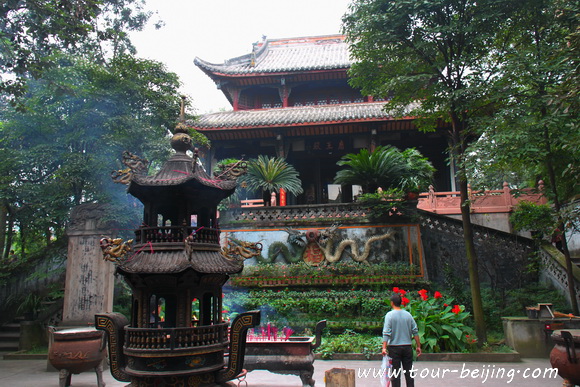
The new hall, built in 1995, is about 18 meters long and 6 meters wide. On the upper floor of the temple is dedicated to the Jade Emperor, a Taoist deity next in rank to the three highest Sanqing deities.
Hassle-free Chengdu Guided Tours
If you don’t want to go the do-it-yourself route and prefer the hassle-free escorted tours, here are some options for Chengdu and Sichuan guided tours:
Chengdu tour
Chengdu Car Rental with Driver
Create My Chengdu Trip
Jiuzhaigou Tour
Sichuan Tour
Further Readings
Top 10 Attractions in Chengdu
Best Time to Visit Chengdu
Chengdu Airport
Railway stations in Chengdu
Chengdu Taxi
How to visit Wuhou Shrine
How to visit Du Fu Thatched Cottage
How to visit Jinsha Site Museum
How to Visit Tomb of Wangjian
How to Visit Wangjiang Tower Park
How to Visit Qingyang Palace
How to Visit Jinli Street
How to visit Kuan Alley and Zhai Alley
How to visit Qintai Road, Qintai Street Chengdu
How to visit Shaoling Road Bar Street
How to Visit Jiuyanqiao Bar Street
The Old Teahouse in Pengzhen Town, Chengdu
Drive from Hanzhong to Ya’an
Ya’an Night View
Most Beautiful Sky Road in China
Night View of Moxi Old Town
Camp No.03 at Hailuogou Glacier
Camp No.04 at Hailuogou Glacier
Night View of Kangding
Drive from Kangding to Xinduqiao
Drive from Xinduqiao to Danba
Jiarong Tibetan Blockhouses
Jiarong Tibetan Ancient Watchtowers
Drive from Xinduqiao to Yajiang
Drive from Yajiang to Litang
Drive from Litang to Daocheng
Drive from Litang to Batang
Drive from Batang to Mangkang
Drive from Shangri-la to Daocheng
Drive from Daocheng to Yading
Yading Brings You Inner Peace
Bipenggou is a fairyland in Autumn
When is the best time to visit Jiuzhaigou?
Best Places to Visit Autumn Leaves in Sichuan
Top 10 Places to Visit in Sichuan
Ruoergai Grassland, my first trip to Ruoergai Grassland
Any questions, just drop a line.





